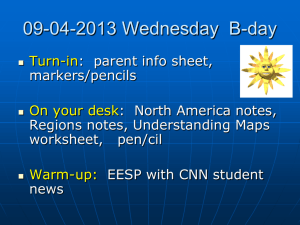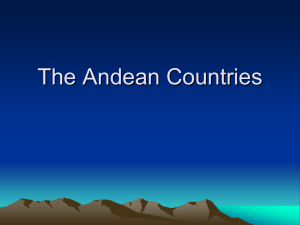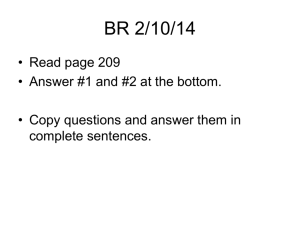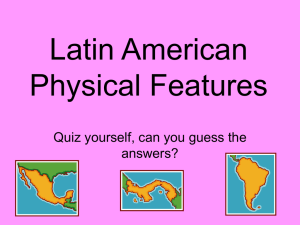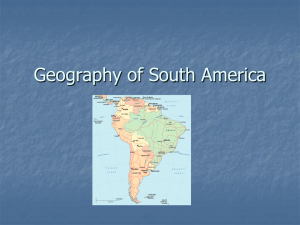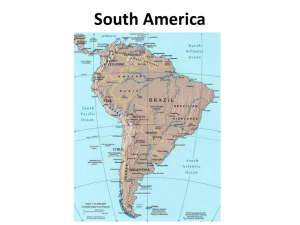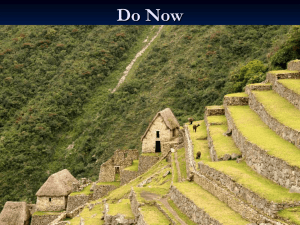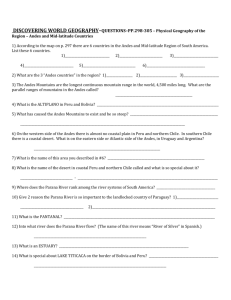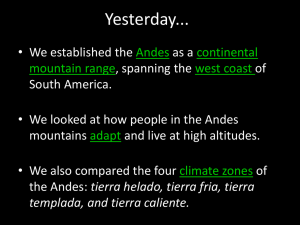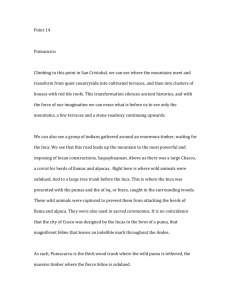Latin America - Land and Climate
advertisement
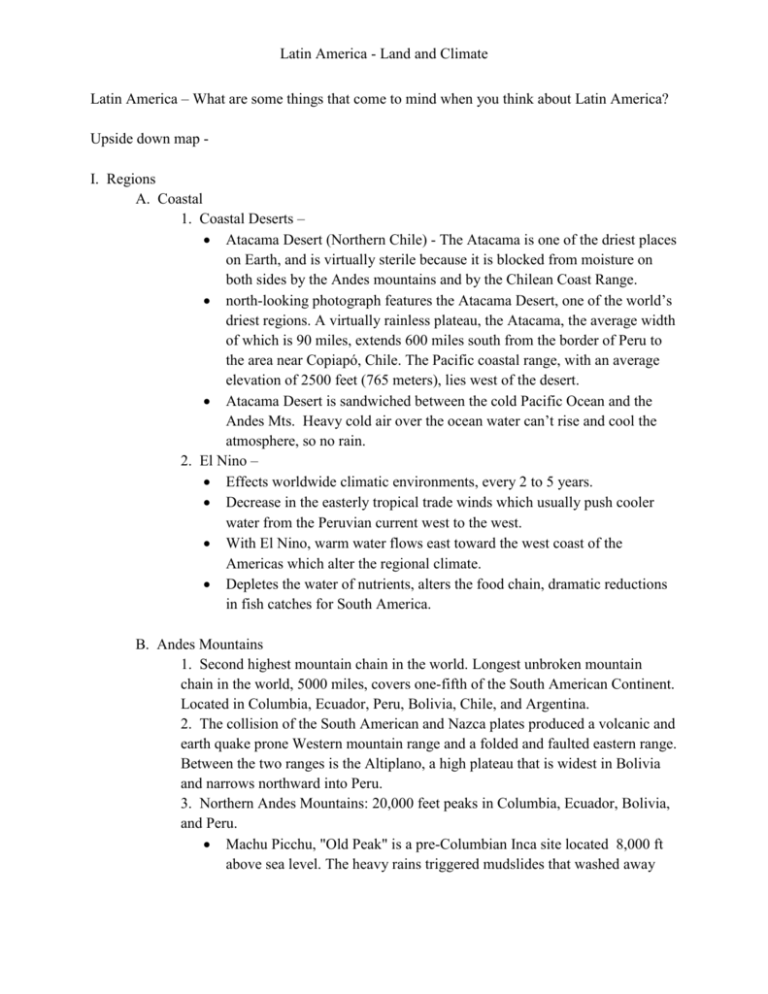
Latin America - Land and Climate Latin America – What are some things that come to mind when you think about Latin America? Upside down map I. Regions A. Coastal 1. Coastal Deserts – Atacama Desert (Northern Chile) - The Atacama is one of the driest places on Earth, and is virtually sterile because it is blocked from moisture on both sides by the Andes mountains and by the Chilean Coast Range. north-looking photograph features the Atacama Desert, one of the world’s driest regions. A virtually rainless plateau, the Atacama, the average width of which is 90 miles, extends 600 miles south from the border of Peru to the area near Copiapó, Chile. The Pacific coastal range, with an average elevation of 2500 feet (765 meters), lies west of the desert. Atacama Desert is sandwiched between the cold Pacific Ocean and the Andes Mts. Heavy cold air over the ocean water can’t rise and cool the atmosphere, so no rain. 2. El Nino – Effects worldwide climatic environments, every 2 to 5 years. Decrease in the easterly tropical trade winds which usually push cooler water from the Peruvian current west to the west. With El Nino, warm water flows east toward the west coast of the Americas which alter the regional climate. Depletes the water of nutrients, alters the food chain, dramatic reductions in fish catches for South America. B. Andes Mountains 1. Second highest mountain chain in the world. Longest unbroken mountain chain in the world, 5000 miles, covers one-fifth of the South American Continent. Located in Columbia, Ecuador, Peru, Bolivia, Chile, and Argentina. 2. The collision of the South American and Nazca plates produced a volcanic and earth quake prone Western mountain range and a folded and faulted eastern range. Between the two ranges is the Altiplano, a high plateau that is widest in Bolivia and narrows northward into Peru. 3. Northern Andes Mountains: 20,000 feet peaks in Columbia, Ecuador, Bolivia, and Peru. Machu Picchu, "Old Peak" is a pre-Columbian Inca site located 8,000 ft above sea level. The heavy rains triggered mudslides that washed away Latin America - Land and Climate parts of the only railroad that connects the mountaintop ruins with the nearby city of Cusco. Apart from the train, the only ways to reach Machu Picchu -- the impressively intact remains of an Incan city shrouded by thick jungle -- are to trek some 28 miles through steep mountain passes, or fly by helicopter. The Peruvian government airlifted some 4,000 travelers from the site in January after the heaviest rains in the region in 15 years stranded them and killed five people. 4. Paramos – Andean highlands in Ecuador and Columbia – a series of highland valleys and plateaus. Páramo is the geographic term for the area between the uppermost treeline and the year-round snow line. It is found only in high elevations and is usually covered in thick, hardy grasses. 5. Spreads out into the Cordillera, with plateaus and canyons (some 2 times as deep as the Grand Canyon). 6. Southern Andes Mountains: Narrow, snowfilled, with glaciers in Chile and Argentina. 7. Active Volcanoes In Andes Mts – The western coastline of South America include numerous active stratovolcanoes (steep-sided, cone-shaped volcanoes). The majority of these volcanoes were formed and are still fed by magma generated as the Nazca tectonic plate under the southeastern Pacific Ocean moves northeastward and plunges beneath the South American continental plate-a process known as subduction. 8. Climate of Andes Mountains is Highland, Arid, or Semi-Arid. C. Highlands 1. Cover 1/3 of the continent. 2. Consist of plateaus, hills, and low mountains. 3. Highlands include Guiana, Brazilian, and Patagonia. 4. Guiana Highlands – Mountains worn down to rounded hills and tabletops at edge of one table land. Highest waterfall in the world – Angel Falls in Venezuela (20 times the height of Niagara Falls). Escarpment - steep slope with a nearly flat plateau on top 5. Brazilian Highlands – Largest of all highlands. Latin America - Land and Climate Most people live in the eastern part. Brazil goes from costal lowlands to highland plateau and drops to Amazon Basin. Survivor 6. Patagonia Cool and dry (arid to semi-arid) Barren land between the Andes and the Atlantic. On the western edge are lakes formed by glaciers thousands of years ago. The wind-whipped tip of South America, Patagonia occupies a pristine, 260,000-square-mile expanse of southern Argentina and Chile. Never precisely defined, the dry, desolate region extends from the Río Colorado south to the tip of the continent. From the dramatic peaks of the Andes and the grinding ice fields of Glaciers National Park to the arid steppes of the east, Patagonia is South America's frontier—harsh, unspoiled, raw. Today, Patagonia is a sparsely populated area rich in natural resources and wildlife, including herons, condors, pumas, tortoises, and guanacos. Sheep herding, oil, mining, agriculture, and tourism make up Patagonia's economy. Industry: Petroleum, natural gas, tourism, iron ore, coal, manganese. Agriculture: Peaches, almonds, apples, pears, olives, grapes, sheep. Exports: Crude oil, gas, fruit, wool products. D. Lowlands 1. Amazon River Basin Drained by Amazon River and its tributaries. the largest river in the world by volumetric discharge, with a total river flow greater than the next ten largest rivers combined. The Amazon, which has the largest drainage basin in the world, accounts for approximately one-fifth of the world's total river flow. (Amazon to Atlantic Ocean) 2000 miles across (Andes to Atlantic Ocean). 800 miles (north to south). cerrado – savannas with flat terrain and moderate rainfall that is suitable for farming. Much of this land is undeveloped. The government of Brazil is encouraging settlers to move into the interior and develop the land. Climate tropical wet. Rainforest - More than one-third of all species in the world live in the Amazon Rainforest, a giant tropical forest and river basin with an area that Latin America - Land and Climate 2. 3. 4. 1. stretches more than 2.1 million sq mi, and is the richest tropical forest in the world. The Amazon River has over 3,000 recognized species of fish and that number is still growing. Gran Chaco “hunting land” Eastern Bolivia, Paraguay, Argentina Semi-arid and humid subtropical climate Gran Chaco has some of the highest temperatures on the continent. The Chaco offers high soil fertility and a topography that is favorable for agricultural development, but in combination with aspects that are challenging for farming: a semi-arid to semi-humid climate (20-50 inches annual rainfall) with a six-month dry season and sufficient fresh groundwater available only in roughly one third of the region, the remaining aquifers are too salty. Pampas “plain” Grasslands and forests with rich soil. The main product of the pampas is cattle and wheat. Gauchos – cowboys of Argentina and Uruguay. Fertile. One of the most important agricultural areas in the world. Humid subtropical and arid climate. Llanos “the plains” Columbia and Venezuela. Few people live here. Llano – Flat grasslands with low hills and scattered patches of trees. Used for farming and livestock grazing. Similar to the Great Plains in U.S. The prime economic activity of the area came from the herding of millions of heads of cattle. The term llanero ("plainsman") became synonymous with the cowhands that took care of the herds, and had some cultural similarities to the compare to the gauchos of the Pampas or the vaqueros of Spanish and Mexican Texas. The climate change of the Llanos is extreme. During the rainy season from May to October, parts of the Llanos can flood up to a meter. This turns the forests and grassland to be turned into a temporary wetland. This flooding also makes the area unique for its wildlife. The area supports around 70 species of water birds, including 90% of the endangered species, the Scarlet Ibis. The area slopes gradually away from the highland areas that surround it; elevation above sea level in the llanos area never exceeds 200 meters. Orinoco River Both sides of Orinoco River – rainy season April-December; Dry rest of the year. Latin America - Land and Climate The Orinoco is one of the longest rivers in South America at 1,330 miles. Its drainage basin, sometimes called the Orinoquia is 76.3% in Venezuela with the rest in Colombia. The Orinoco and its tributaries are the major transportation system for eastern and interior Venezuela and the llanos of Colombia. To Atlantic Ocean Cape Horn: Cape Horn is the southernmost headland of the Tierra del Fuego archipelago of southern Chile. Cape Horn is widely considered to be the most southerly point of South America, and marks the northern boundary of the Drake Passage; for many years it was a major milestone on the clipper route, by which sailing ships carried trade around the world. However, the waters around the cape are particularly hazardous, owing to strong winds, large waves, strong currents and icebergs; these dangers have made it notorious as a sailors' graveyard. The need for ships to round the Cape Horn was greatly reduced by the opening of the Panama Canal in 1914. Mexico – High altitude plateaus between the eastern and western Sierra Madres dominate northern Mexico. This plateau rises over 6000 feet and contains shallow basins. The western slopes facing the Pacific Ocean are steep, but those on the east are less steep with wide costal plains. A large limestone platform emerged from the seafloor to form the Yucatan Peninsula. Central America Subject to earthquakes and volcanic eruptions where the tectonic plates collide. Major earthquake in Mexico devastated Mexico City in 1985. There are 25 active volcanoes between N. Mexico and Columbia. Caribbean Islands – N. American plate drove into the Caribbean plate producing intense volcanic activity along the plate margin and formed the Lesser Antilles arc. In terms of geology, the Greater Antilles (Cuba, Dom Rep, Haiti, Jamaica, Puerto Rico) are made up of continental rock b/c of plate movements, as distinct from the Lesser Antilles (Barbados, Anguilla), which are mostly young volcanic or coral islands (flat limestone islands constructed of coral reefs on top of subsiding former volcanic peaks). Tomorrow: Human-Environment Interaction How does the physical geography affect where people live, how they earn their living, transportation, communication, political situations?
